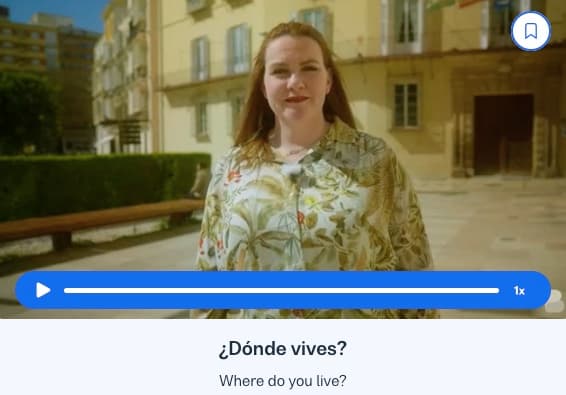I want to learn...
Mastering a new language like Spanish can be both exciting and challenging. And verbs are crucial for expressing actions, states, and conditions in Spanish.
Understanding present verb conjugations is essential for a strong language foundation.
In this article, you’ll explore Spanish verbs in the present tense and learn all you need to know to have a conversation in Spanish.
Basic Spanish present verb conjugations
The present simple tense is used to express usual actions, common truths, or ongoing states in the present.
To conjugate regular verbs in the present simple tense, follow these general rules:
For -ar verbs:
yo (-o)
tú (-as) él / ella / usted (-a)
nosotro / nosotras (-amos)
vosotros / vosotras (-áis)
ellos / ellas / ustedes (-an)
For -er verbs:
yo (-o)
tú (-es)
él / ella / usted (-e)
nosotros / nosotras (-emos)
vosotros / vosotras (-éis)
ellos / ellas / ustedes (-en)
For -ir verbs (same as -er verbs except for:
nosotros / nosotras (-imos)
vosotros / vosotras (-ís)
Simple present conjugation
| Subject Pronoun | -ar example | -er example | -ir example |
|---|---|---|---|
| Yo | Hablo (I speak) | Como (I eat) | Vivo (I live) |
| Tú | Hablas (You speak) | Comes (You eat) | Vives (You live) |
| Él / Ella | Habla (He/She speaks) | Come (He/She eats) | Vive (He/She lives) |
| Usted | Habla (you - formal speak) | Come (you - formal eat) | Vive (you - formal live) |
| Nosotros | Hablamos (We speak) | Comemos (We eat) | Vivimos (We live) |
| Vosotros | Habláis (You all speak) | Coméis (You all eat) | Vivís (You all live) |
| Ellos / Ellas | Hablan (They speak) | Comen (They eat) | Viven (They live) |
| Ustedes | Hablan (You all speak) | Comen (You all eat) | Viven (You all live) |
Present continuous tense
The present continuous tense is used to express actions happening now that have some duration. To form the present continuous tense in Spanish, follow these steps:
Conjugate the verb estar (to be) in the present simple tense according to the subject.
Add the gerund form (-ando for -ar verbs and -iendo for -er and -ir verbs) of the main verb.
Present continuous tense examples
| Subject Pronoun | -ar example | -er & -ir example |
|---|---|---|
| Yo | Estoy hablando (I am speaking) | Estoy comiendo (I am eating) |
| Tú | Estoy hablando (I am speaking) | Estoy comiendo (I am eating) |
| Tú | Estás hablando (You are speaking) | Estás comiendo (You are eating) |
| Él / Ella | Está hablando (He/She is speaking) | Está comiendo (He/She is eating) |
| Usted | Está hablando (you - formal are speaking) | Está comiendo (you - formal are eating) |
| Nosotros | Estamos hablando (We are speaking) | Estamos comiendo (We are eating) |
| Vosotros | Estáis hablando (You all are speaking) | Estáis comiendo (You all are eating) |
| Ellos / Ellas | Están hablando (They are speaking) | Están comiendo (They are eating) |
| Ustedes | Están hablando (you all are speaking) | Están comiendo (you all are eating) |
Present perfect tense
The present perfect tense is used to describe past actions or experiences that have a connection to the present. To form the present perfect tense in Spanish, follow these steps:
Conjugate the auxiliary verb haber (to have) in the present simple tense according to the subject.
Add the past participle of the main verb. The endings are only -ado for -ar verbs, and -ido for -er and -ir verbs.
Present perfect tense conjugations
| Subject Pronoun | -ar example | -er & -ir example |
|---|---|---|
| Yo | He hablado (I have spoken) | He comido (I have eaten) |
| Tú | Has hablado (You have spoken) | Has comido (You have eaten) |
| Él / Ella | Ha hablado (He/She has spoken) | Ha comido (He/She has eaten) |
| Usted | Ha hablado (you - formal have spoken) | Ha comido (you - formal have eaten) |
| Nosotros | Hemos hablado (We have spoken) | Hemos comido (We have eaten) |
| Vosotros | Habéis hablado (You all have spoken) | Habéis comido (You all have eaten) |
| Ellos / Ellas | Han hablado (They have spoken) | Han comido (They have eaten) |
| Ustedes | Han hablado (You all have spoken) | Han comido (You all have eaten) |
Note: While Latin Americans use the simple past, the present perfect is used in Spain to convey the same meaning.
Present perfect continuous tense
The present perfect continuous tense is used to describe ongoing actions that started in the past and continue up to the present. To form it all you need is to:
Conjugate the auxiliary verb haber (to have) in the present simple tense according to the subject.
Add the gerund form (-ando for -ar verbs and -iendo for -er and -ir verbs) of the main verb.
Example conjugations in the present perfect continuous tense
| Subject Pronoun | -ar example | -er & -ir example |
|---|---|---|
| Yo | He estado hablando (I have been speaking) | He estado comiendo (I am eating) |
| Tú | Has estado hablando (You have been speaking) | Has estado comiendo (You have been speaking) |
| Él / Ella | Ha estado hablando (He/She has been speaking) | Ha estado comiendo (He/She has been eating) |
| Usted | Ha estado hablando (you - formal have been speaking) | Ha estado comiendo (you - formal have been eating) |
| Nosotros | Hemos estado hablando (We have been speaking) | Hemos estado comiendo (We have been eating) |
| Vosotros | Habéis estado hablando (You all have been speaking) | Habéis estado comiendo (You all have been eating) |
| Ellos / Ellas | Han estado hablando (They have been speaking) | Han estado comiendo (They have been eating) |
| Ustedes | Han estado hablando (You all have been speaking) | Han estado comiendo (You all have been eating) |
Special cases and exceptions
Irregular verbs
While regular verbs follow the aforementioned conjugation patterns, many common Spanish verbs are irregular in the present tense. Irregular verbs have unique conjugations that must be memorized.Ser,tenerandestarare three pretty common examples.
Examples of irregular verb conjugation: Ser, tener and estar
| Subject Pronoun | Ser (to be) | Estar (to be) | Tener (to have) |
|---|---|---|---|
| Yo | Soy | Estoy | Tengo |
| Tú | Eres | Estás | Tienes |
| Él / Ella | Es | Está | Tiene |
| Usted | Es | Está | Tiene |
| Nosotros | Somos | Estamos | Tenemos |
| Vosotros | Sois | Estáis | Tenéis |
| Ellos / Ellas | Son | Están | Tienen |
| Ustedes | Son | Están | Tienen |
Stem-changing verbs
In addition to irregular verbs, Spanish also has stem-changing verbs. These are also known as "boot verbs" due to their unique conjugation patterns.
Stem-changing verbs undergo changes in the stem vowel in the present tense for all subjects exceptnosotros / nosotrasandvosotros / vosotras. The most common stem changes occur in-arand-erverbs:
E → IE: (e.g.,
yo pienso
tú piensas
él / ella / usted piensa
nosotros / nosotras pensamos
vosotros / vosotras pensáis
ellos / ellas / ustedes piensan
O → UE (e.g.,
yo puedo
tú puedes
él / ella / usted puede
nosotros / nosotras podemos
vosotros / vosotras podéis
ellos / ellas / ustedes pueden
It is essential to consult a reliable Spanish grammar resource like the Busuu app to learn and practice these special cases.
Reflexive verbs
Reflexive verbs are used to describe actions that a subject performs on themselves. Reflexive verbs are conjugated in all their forms with a reflexive pronoun which must always agree with the subject in person and number, as you will see below:
Levantarse
Yo me levanto
Tú te levantas
Él / ella / usted se levanta
Nosotros / nosotras nos levantamos
Vosotros / vosotras os levantáis
Ellos / ellas / ustedes se levantan
Spanish present tense conjugations: Recap
Understanding the regular conjugation patterns, memorizing irregular verbs, and grasping stem-changing and reflexive verbs will greatly enhance your ability to express yourself in Spanish.
Remember, practice is key, so make use of various resources to reinforce your understanding of Spanish present verbs.
With dedication and consistent effort, you'll soon find yourself talking fluently and with confidence with Spanish-speaking natives.
Newlanguages


